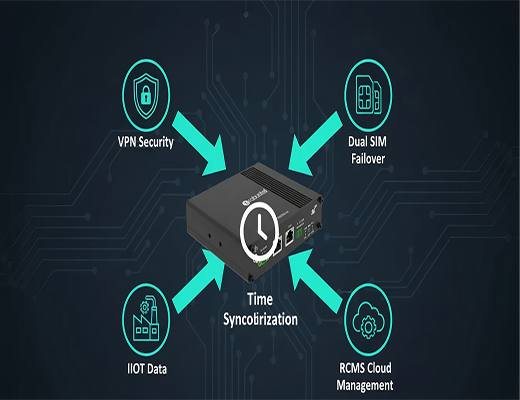
Robustel R5020 Lite NTP Setup: Online and Windows Server Guide
|
|
Time to read 7 min
|
|
Time to read 7 min
This article is a comprehensive guide focused exclusively on the Robustel R5020 Lite NTP setup and time synchronization.
We explore why precise timekeeping is mission-critical for leveraging the R5020 Lite's advanced 5G capabilities in industrial applications, impacting data integrity, VPN security, and dual-SIM failover diagnostics.
The guide details three primary synchronization methods available in RobustOS: using public internet servers, leveraging the router's onboard GNSS module for high precision, and a step-by-step tutorial on configuring a local Windows PC as an NTP server for secure, air-gapped deployments. This ensures your R5020 Lite operates with perfect timing in any network environment.
So, you've chosen the Robustel R5020 Lite. [cite_start]You've invested in a powerhouse of an industrial router, ready to leverage its cutting-edge 5G (3GPP Release 16) capabilities, enterprise-grade security, and rugged design for your mission-critical application[cite: 311, 390]. But to truly unlock the full potential of this device and the data it handles, there's a foundational setting that is too often overlooked: time. I've seen it in the field—an engineer trying to diagnose a cellular failover event on an R5020 Lite, only to find the logs from the two SIMs are timestamped minutes apart, making a clear analysis impossible.
[cite_start]Your R5020 Lite isn't just a modem; it's a sophisticated device running the secure, Linux-based RobustOS, designed for complex tasks like primary broadband, SD-WAN failover, and industrial automation[cite: 310, 316, 319]. Every security certificate, every VPN tunnel, every data log, and every remote command sent through the RCMS cloud platform hinges on one simple thing: an accurate clock.
This guide is designed specifically for you, the R5020 Lite user. We're going to move beyond the "why" and get deep into the "how." We will explore all the Robustel R5020 Lite NTP setup options, from the simple to the advanced. And most importantly, we will provide a detailed solution for the ultimate industrial challenge: keeping your router perfectly synchronized in a high-security, completely offline network.
Before diving into configuration menus, it's crucial to understand how precise time impacts the specific features of your R5020 Lite. This isn't just about having the right time on a dashboard; it's about enabling the router's core functions to perform reliably.
In essence, a proper Robustel R5020 Lite NTP setup is the first step to ensuring the reliability and security of your entire solution.
For any R5020 Lite with a direct internet connection, this is the simplest method.
For applications demanding high accuracy or operating in mobile environments, the R5020 Lite's optional GNSS capability is the superior choice.
This brings us to the most demanding industrial scenario: your R5020 Lite is deployed in a high-security private network—like a factory floor, a bank branch, or a critical infrastructure site—with no access to the public internet. GPS signals may also be unavailable indoors. How do you keep the clock accurate?
The answer is to create your own local time server. Here’s how to configure a standard Windows machine as a reliable NTP source for your R5020 Lite.
First, you must ensure the Windows Time service (w32time) is running and set to start automatically.
Win + R), type services.msc, and hit Enter.Now, we use PowerShell (run as Administrator) to make the necessary registry changes.
Set the Time Source to Local & Mark as Reliable: This command tells the server to use its own internal clock as the master source for the network.
w32tm /config /manualpeerlist:"127.0.0.1" /syncfromflags:manual /reliable:yes /updateRestart-Service w32TimeEnable the NTP Server Functionality: This activates the server component, allowing it to respond to NTP requests.
Set-ItemProperty -Path "HKLM:\SYSTEM\CurrentControlSet\Services\w32time\TimeProviders\NtpServer" -Name "Enabled" -Value 1Announce as an Authoritative Time Source: This tells the server to advertise itself as the primary time source on the network.
Set-ItemProperty -Path "HKLM:\SYSTEM\CurrentControlSet\services\W32Time\Config" -Name "AnnounceFlags" -Value 5Restart the Service: This final command applies all changes.
Restart-Service w32TimeYour Windows machine is now a functioning NTP server.
The final and most important step is to point your R5020 Lite to your new time server.
pool.ntp.org).192.168.0.35).A1: The most accurate time source is the optional onboard GNSS module. It receives time signals directly from satellites, making it independent of any network and accurate to the sub-millisecond level. This is the recommended method for mobile applications or when the highest precision is required.
A2: If the R5020 Lite loses connection to its configured NTP source (internet, GNSS, or local server), it will rely on its internal hardware clock (RTC). This clock will drift over time. This is precisely why having a reliable and consistently available time source, like a local Windows NTP server in an offline environment, is critical for maintaining long-term data integrity.
A3: Yes. This is a key advantage of using the Robustel ecosystem. Through the RCMS cloud platform, you can create a configuration template with your desired NTP server settings and push it to hundreds or thousands of R5020 Lite routers simultaneously. This ensures consistent timekeeping across your entire deployment without manual intervention.




